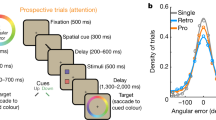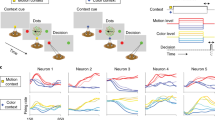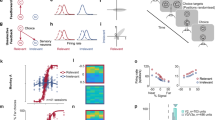Abstract
The frontal pole cortex (FPC) expanded markedly during human evolution, but its function remains uncertain in both monkeys and humans. Accordingly, we examined single-cell activity in this area. On every trial, monkeys decided between two response targets on the basis of a 'stay' or 'shift' cue. Feedback followed at a fixed delay. FPC cells did not encode the monkeys' decisions when they were made, but did so later on, as feedback approached. This finding indicates that the FPC is involved in monitoring or evaluating decisions. Using a control task and delayed feedback, we found that decision coding lasted until feedback only when the monkeys combined working memory with sensory cues to 'self-generate' decisions, as opposed to when they simply followed trial-by-trial instructions. A role in monitoring or evaluating self-generated decisions could account for FPC's expansion during human evolution.
This is a preview of subscription content, access via your institution
Access options
Subscribe to this journal
Receive 12 print issues and online access
$209.00 per year
only $17.42 per issue
Buy this article
- Purchase on Springer Link
- Instant access to full article PDF
Prices may be subject to local taxes which are calculated during checkout








Similar content being viewed by others
References
Walker, A.E. A cytoarchitectual study of the prefrontal areas of the macaque monkey. J. Comp. Neurol. 73, 59–86 (1940).
Ramnani, N. & Owen, A.M. Anterior prefrontal cortex: insights into function from anatomy and neuroimaging. Nat. Rev. Neurosci. 5, 184–194 (2004).
Burgess, P.W., Simons, J.S., Dumontheil, I. & Gilbert, S.J. The gateway hypothesis of rostral prefrontal cortex (area 10) function, in Measuring the Mind: Speed, Control, and Age (eds Duncan, J., McLeod, P. & Phillips, L.) 215–246 (Oxford University Press, Oxford, 2009).
Ongür, D., Ferry, A.T. & Price, J.L. Architectonic subdivision of the human orbital and medial prefrontal cortex. J. Comp. Neurol. 460, 425–449 (2003).
Semendeferi, K., Armstrong, E., Schleicher, A., Zilles, K. & Van Hoesen, G.W. Prefrontal cortex in humans and apes: a comparative study of area 10. Am. J. Phys. Anthropol. 114, 224–241 (2001).
Jones, E.G. & Powell, T.P.S. An anatomical study of converging sensory pathways within the cerebral cortex of the monkey. Brain 93, 793–820 (1970).
Carmichael, S.T. & Price, J.L. Connectional networks within the orbital and medial prefrontal cortex of macaque monkeys. J. Comp. Neurol. 371, 179–207 (1996).
Petrides, M. & Pandya, D.N. Efferent association pathways from the rostral prefrontal cortex in the macaque monkey. J. Neurosci. 27, 11573–11586 (2007).
Hagmann, P. et al. Mapping the structural core of human cerebral cortex. PLoS Biol. 6, e159 (2008).
Jacobs, B. et al. Regional dendritic and spine variation in human cerebral cortex: a quantitative Golgi study. Cereb. Cortex 11, 558–571 (2001).
Sakai, K. Task set and prefrontal cortex. Annu. Rev. Neurosci. 31, 219–245 (2008).
Okuda, J. et al. Differential involvement of regions of rostral prefrontal cortex (Brodmann area 10) in time- and event-based prospective memory. Int. J. Psychophysiol. 64, 233–246 (2007).
McClure, S.M., Ericson, K.M., Laibson, D.I., Loewenstein, G. & Cohen, J.D. Time discounting for primary rewards. J. Neurosci. 27, 5796–5804 (2007).
Koechlin, E., Basso, G., Pietrini, P., Panzer, S. & Grafman, J. The role of the anterior prefrontal cortex in human cognition. Nature 399, 148–151 (1999).
Daw, N.D., O'Doherty, J.P., Dayan, P., Seymour, B. & Dolan, R.J. Cortical substrates for exploratory decisions in humans. Nature 441, 876–879 (2006).
Soon, C.S., Brass, M., Heinze, H.J. & Haynes, J.D. Unconscious determinants of free decisions in the human brain. Nat. Neurosci. 11, 543–545 (2008).
Ramnani, N., Elliott, R., Athwal, B.S. & Passingham, R.E. Prediction error for free monetary reward in the human prefrontal cortex. Neuroimage 23, 777–786 (2004).
Boorman, E.D., Behrens, T.E.J., Woolrich, M.W. & Rushworth, M.F.S. How green is the grass on the other side? Frontopolar cortex and the evidence in favor of alternative courses of action. Neuron 62, 733–743 (2009).
Burgess, P.W., Dumontheil, I. & Gilbert, S.J. The gateway hypothesis of rostral prefrontal cortex (area 10) function. Trends Cogn. Sci. 11, 290–298 (2007).
Kroger, J.K. et al. Recruitment of anterior dorsolateral prefrontal cortex in human reasoning: a parametric study of relational complexity. Cereb. Cortex 12, 477–485 (2002).
Bunge, S.A., Helskog, E.H. & Wendelken, C. Left, but not right, rostrolateral prefrontal cortex meets a stringent test of the relational integration hypothesis. Neuroimage 46, 338–342 (2009).
Christoff, K., Ream, J.M., Geddes, L.P. & Gabrieli, J.D. Evaluating self-generated information: anterior prefrontal contributions to human cognition. Behav. Neurosci. 117, 1161–1168 (2003).
Zysset, S., Huber, O., Ferstl, E. & von Cramon, D.Y. The anterior frontomedian cortex and evaluative judgment: an fMRI study. Neuroimage 15, 983–991 (2002).
Ganis, G., Kosslyn, S.M., Stose, S., Thompson, W.L. & Yurgelun-Todd, D.A. Neural correlates of different types of deception: An fMRI investigation. Cereb. Cortex 13, 830–836 (2003).
Karim, A.A. et al. The truth about lying: Inhibition of the anterior prefrontal cortex improves deceptive behavior. Cereb. Cortex published online, doi:10.1093/cercor/bhp090 (14 May 2009).
Mitz, A.R., Tsujimoto, S., Maclarty, A.J. & Wise, S.P. A method for recording single-cell activity in the frontal-pole cortex of macaque monkeys. J. Neurosci. Methods 177, 60–66 (2009).
Genovesio, A., Brasted, P.J., Mitz, A.R. & Wise, S.P. Prefrontal cortex activity related to abstract response strategies. Neuron 47, 307–320 (2005).
Genovesio, A., Brasted, P.J. & Wise, S.P . Representation of future and previous spatial goals by separate neural populations in prefrontal cortex. J. Neurosci. 26, 7305–7316 (2006).
Tsujimoto, S., Genovesio, A. & Wise, S.P. Transient neuronal correlations underlying goal selection and maintenance in prefrontal cortex. Cereb. Cortex 18, 2748–2761 (2008).
Wise, S.P. Forward frontal fields: phylogeny and fundamental function. Trends Neurosci. 31, 599–608 (2008).
Pochon, J.B. et al. The neural system that bridges reward and cognition in humans: an fMRI study. Proc. Natl. Acad. Sci. USA 99, 5669–5674 (2002).
Schall, J.D., Stuphorn, V. & Brown, J.W. Monitoring and control of action by the frontal lobes. Neuron 36, 309–322 (2002).
Kiani, R. & Shadlen, M.N. Representation of confidence associated with a decision by neurons in the parietal cortex. Science 324, 759–764 (2009).
Kepecs, A., Uchida, N., Zariwala, H.A. & Mainen, Z.F. Neural correlates, computation and behavioural impact of decision confidence. Nature 455, 227–231 (2008).
Genovesio, A., Tsujimoto, S. & Wise, S.P. Encoding problem-solving strategies in prefrontal cortex: activity during strategic errors. Eur. J. Neurosci. 27, 984–990 (2008).
van Duijvenvoorde, A.C.K., Zanolie, K., Rombouts, S.A., Raijmakers, M.E. & Crone, E.A. Evaluating the negative or valuing the positive? Neural mechanisms supporting feedback-based learning across development. J. Neurosci. 28, 9495–9503 (2008).
Walsh, N.D. & Phillips, M.L. Interacting outcome retrieval, anticipation, and feedback processes in the human brain. Cereb. Cortex published online, doi:10.1093/cercor/bhp098 (8 May 2009).
Lawrence, N.S., Jollant, F., O'Daly, O., Zelaya, F. & Phillips, M.L. Distinct roles of prefrontal cortical subregions in the Iowa gambling task. Cereb. Cortex 19, 1134–1143 (2009).
Burgess, P.W. Function and localization within rostral prefrontal cortex (area 10). Philos. Trans. R. Soc. Lond. B Biol. Sci. 362, 887–899 (2007).
Gilbert, S.J. et al. Functional specialization within rostral prefrontal cortex (area 10): a meta-analysis. J. Cogn. Neurosci. 18, 932–948 (2006).
Mason, M.F. et al. Wandering minds: the default network and stimulus-independent thought. Science 315, 393–395 (2007).
Gusnard, D.A., Akbudak, E., Shulman, G.L. & Raichle, M.E. Medial prefrontal cortex and self-referential mental activity: relation to a default mode of brain function. Proc. Natl. Acad. Sci. USA 98, 4259–4264 (2001).
Christoff, K., Ream, J.M. & Gabrieli, J.D. Neural basis of spontaneous thought processes. Cortex 40, 623–630 (2004).
Forstmann, B.U., Brass, M., Koch, I. & von Cramon, D.Y. Internally generated and directly cued task sets: an investigation with fMRI. Neuropsychologia 43, 943–952 (2005).
Raichle, M.E. et al. A default mode of brain function. Proc. Natl. Acad. Sci. USA 98, 676–682 (2001).
Bengtsson, S.L., Haynes, J.D., Sakai, K., Buckley, M.J. & Passingham, R.E. The representation of abstract task rules in the human prefrontal cortex. Cereb. Cortex 19, 1929–1936 (2009).
Sakai, K. & Passingham, R.E. Prefrontal set activity predicts rule-specific neural processing during subsequent cognitive performance. J. Neurosci. 26, 1211–1218 (2006).
Bunge, S.A. How we use rules to select actions: a review of evidence from cognitive neuroscience. Cogn. Affect. Behav. Neurosci. 4, 564–579 (2004).
Mithen, S. The Prehistory of the Mind (Thames and Hudson, London, 1996).
Mitz, A.R. A liquid-delivery device that provides precise reward control for neurophysiological and behavioral experiments. J. Neurosci. Methods 148, 19–25 (2005).
Acknowledgements
We thank S. Bunge, G. di Pellegrino, E. Murray, R. Passingham, N. Ramnani and P. Rudebeck for comments on drafts of this manuscript. A. Mitz, J. Fellows and P.-Y. Chen provided technical support. This work was supported by the Division of Intramural Research of the National Institute of Mental Health (Z01MH-01092) and by a Grant-in-Aid for Scientific Research on Innovative Areas (21119513) from the Ministry of Education, Culture, Sports, Science and Technology, Japan. S.T. was supported by a research fellowship from the Japan Society for the Promotion of Science.
Author information
Authors and Affiliations
Contributions
S.T. and S.P.W. conceived and designed the experiment. S.T. and A.G. performed the experiment and analyzed the data. S.T., A.G. and S.P.W. wrote the paper.
Corresponding author
Supplementary information
Supplementary Text and Figures
Supplementary Figures 1–5 and Supplementary Tables 1–3 (PDF 1993 kb)
Rights and permissions
About this article
Cite this article
Tsujimoto, S., Genovesio, A. & Wise, S. Evaluating self-generated decisions in frontal pole cortex of monkeys. Nat Neurosci 13, 120–126 (2010). https://doi.org/10.1038/nn.2453
Received:
Accepted:
Published:
Issue Date:
DOI: https://doi.org/10.1038/nn.2453
This article is cited by
-
Impact of corpus callosum integrity on functional interhemispheric connectivity and cognition in healthy subjects
Brain Imaging and Behavior (2023)
-
Neuronal properties of pyramidal cells in lateral prefrontal cortex of the aging rhesus monkey brain are associated with performance deficits on spatial working memory but not executive function
GeroScience (2023)
-
The prefrontal cortex and (uniquely) human cooperation: a comparative perspective
Neuropsychopharmacology (2022)
-
The Role of Reward System in Dishonest Behavior: A Functional Near-Infrared Spectroscopy Study
Brain Topography (2021)
-
Plastic frontal pole cortex structure related to individual persistence for goal achievement
Communications Biology (2020)



